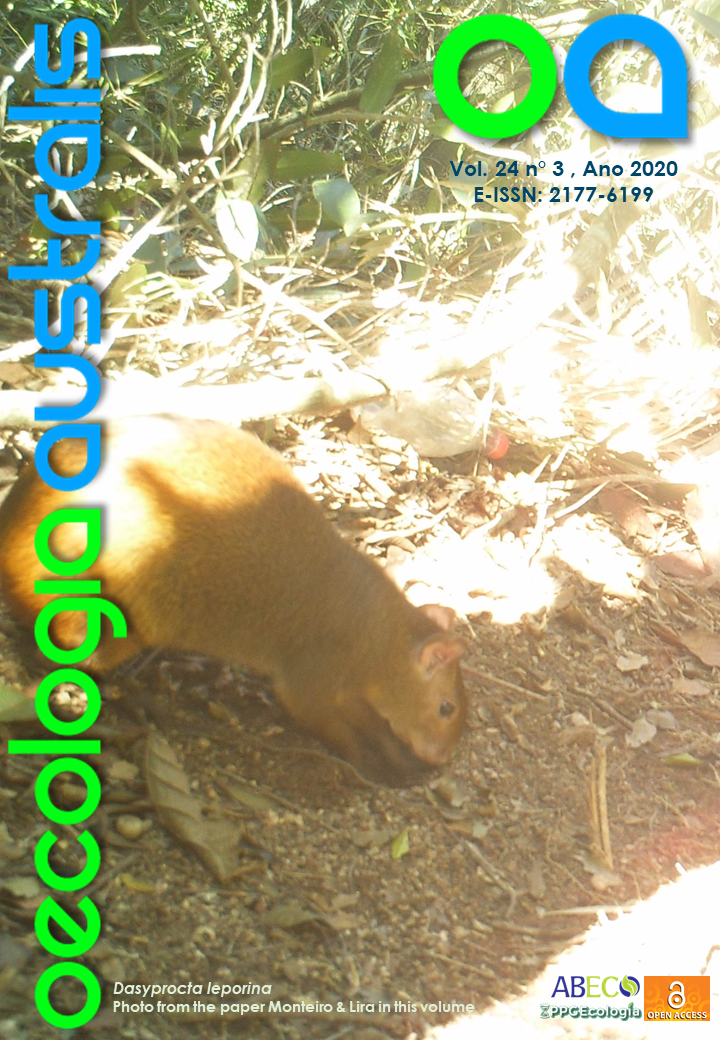POPULATION DENSITY OF Crypturellus noctivagus noctivagus (AVES, TINAMIDAE) IN THE PAMPA BIOME, SOUTHERN BRAZIL
DOI:
https://doi.org/10.4257/oeco.2020.2403.17Keywords:
Distance Sampling, Relictual population, Tinamiformes, Yellow-legged TinamouAbstract
Crypturellus noctivagus noctivagus is a forest bird endemic to Brazil. In the state of Rio Grande do Sul, the species is considered Critically Endangered, and is known for one relictual population in Pampa Biome. In this study, we estimated the population density of this relictual population using the Distance Sampling method. Samplings occurred from September to February, thus comprising three reproductive periods of the species (2012 to 2017). In total, 58 contacts were recorded with C. n. noctivagus individuals in the three reproductive periods. In each reproductive period 81.600 m were covered in trails. We found a density of 0.04 individuals/km², with an average probability of 18 adult individuals. Our results represent the first efforts for density estimation of this relictual population of C. n. noctivagus, which we suggest is composed by the last individuals in the state of Rio Grande do Sul, highlighting the need of local conservation.
Downloads
References
Ayres, M., Ayres, Júnior, M., Ayres, D. L. & Santos, A. A. 2007. Bioestat 5.0 - Aplicações estatísticas nas áreas das ciências biomédicas. Belém, Ong Mamiraua: Brasil: p. 364.
Alvares, C. A, Stape, J. L., Sentelhas, P. C., Gonçalves, J. L., & Sparovek, G. 2013. Köppen’s climate classification map for Brazil. Meteorologische Zeitschrift, 22(6), 711–728. DOI: 10.1127/0941-2948/2013/0507
Anjos, L. dos, Volpato, G. H., Mendonça, L. B., Serafini, P. P., Lopes, E. V., Boçon, R., & Silva, E. S. 2010. Técnicas de levantamento quantitativo de aves em ambiente florestal; uma análise comparativa baseada em dados empíricos. In: Matter, S. V., Straube, F. C., Accordi, I., Piacentini, V., Cândido-Jr, J. F. (Eds.), Ornitologia e Conservação: ciência aplicada, técnica de pesquisa e levantamento. pp.63–73. Rio de Janeiro: Technical Books Editora.
Bencke, G. A., Fontana, C. S., Dias, R. A., Maurício, G. N., & Mähler-Jr, J. K. F. 2003. Aves. In: Fontana, C. S., Bencke, G. A., Reis, R. E. (Eds.), Livro Vermelho da Fauna Ameaçada de Extinção no Rio Grande do Sul. pp. 189–479. Porto Alegre: Edipucrs.
Birdlife International. Species factsheet: Crypturellus noctivagus. 2014. Disponível em: http://www.birdlife.org. Retrieved on January 05, 2014. Avaliable at: http://www.iucnredlist.org/details/22678217/0.DOI:10.2305/IUCN.UK.2016- 3.RLTS.T22678217A92761578.en
Buckland, S. T., Anderson, D. R., Burnham, K. P., Laake, J. L., Borchers, D. L., & Thomas, L. 2001. Introduction to distance sampling: estimating abundance of biological population. Oxford University Press, Oxford: p. 568.
Cabot, J. 1992. Order Tinamiformes. In: Del Hoyo J, Elliott A, Sargatal J. (Eds.), Handbook of the birds of the world. pp. 112–125. Barcelona: Lynx Editions.
Corrêa, L. L. C, Silva, D. E., & Cappellari, L. H. 2010. Aves, Tinamidae, Crypturellus noctivagus noctivagus (Wied, 1820): southward range extension and rediscovery in Rio Grande do Sul, Brazil. ChekList 6(4), 485-486. 10.15560/6.4.585
Corrêa, L. L. C., & Petry, M. V. 2019. Stomach content analysis of Crypturellus noctivagus noctivagus (Tinamiformes, Tinamidae) in southern Brazil. Oecologia Australis, 23(1): 145–149, 2019. DOI: 10.4257/oeco.2019.2301.13
Corrêa, L. L. C., & Petry, M.V. 2018. Testing capturing methods for the Yellow-legged Tinamou Crypturellus noctivagus (Wied, 1820) (Aves, Tinamidae) in southern Brazil. Papéis Avulsos de Zoologia 58,1–4. 10.11606/1807-0205/2018.58.07
Corrêa, L. L. C., Oliveira, S. V., Silva, D. E., & Petry, M. V. 2019. Occurrence and predictive distribution of Crypturellus noctivagus (Aves, Tinamidae) in Brazil. Oecologia Australis, 23(3):548–561. DOI: 10.4257/oeco.2019.2303.13
Ferreguetti, A. C., Pereira-Ribeiro, J., Tomas, W. M., Bergallo, H. G., & Rocha, C. F. D. 2018. Density, habitat use, and activity patterns of a vulnerable population of the Solitary Tinamou (Tinamus solitarius) in a Brazilian Atlantic Forest fragment. Canadian Journal of Zoology, 96(3): 245–252. DOI: 10.1139/cjz-2017-0153
IBGE – Instituto Brasileiro de Geografia e Estatística. 2004. Mapa de Vegetação e Biomas do Brasil, Escala: 1:5.000.000. Retrieved on January 20, 2019. Available at: https://ww2.ibge. gov.br/home/presidencia/noticias/21052004biomashtml.shtm.
Negret, P. J., Garz, O., Stevenson, P., & Laverde-R, O. 2015. The enigmatic Black Tinamou: do distribution, climate, and vocalizations reveal more than one species? . Ornithological Advances 132(1),132–139. 10.1642/AUK-14-183.1
Piacentini, V. Q., Aleixo, A., Agne, C. E., Maurício, G. N., Pacheco, J. F., Bravo, G. A., Brito, G. R.R., Naka, L. N., Olmos, F., Posso, S., Silveira, L. F., Betini, G. S., Carrano, E., Franz, I., Lees, A. C., Lima, L. M., Pioli, D., Schunck, F., Amaral, F. R. do, Bencke, G. A., Cohn-Haft, M., Figueiredo, L. F. A., Straube, F. C., & Cesari, E. 2015. Annotated checklist of the birds of Brazil by the Brazilian Ornithological Records Committee / Lista comentada das aves do Brasil pelo Comitê Brasileiro de Registros Ornitológicos. Revista Brasileira de Ornitologia, 23(2), 90–298.
Rio Grande do Sul. 2014. Espécies da Fauna silvestre ameaçada de extinção ou regionalmente extintas no Estado do Rio Grande do Sul. Decreto N° 51.797. Retrieved on January 20, 2019. Avaliable at: http://www.fzb.rs.gov.br.
São Bernardo, C. S. 2004. Abundância, Densidade e Tamanho Populacional de Aves e Mamíferos Cinegéticos no Parque Estadual Ilha Cardoso, SP, Brasil. Master Thesis. Interunidades em Ecologia Aplicada - Universidade de São Paulo, São Paulo, Brasil: p. 176.
Sick, H. 1997. Ornitologia Brasileira. Rio de Janeiro: Nova Fronteira, Brasil: p. 862.
Thomas, L., Buckland, S. T., Rexstad, E. A., Laake, J. L., Strindberg, S., Hedley,S. L., Bishop, J. R. B., Marques, T. A., & Burnham, K. P. 2010. Distance software: design and analysis of distance sampling surveys for estimating population size. Journal of Applied Ecology, 47(1): 5–14. DOI: 10.1111/j.1365-2664.2009.01737.x
Thomas, L., Llake, J. L., Strindberg, S., Marques, F. F. C., Buckland, K. P., Borchers, D. L., Anderson, D. R., Burnham, K. P., Hedley, S. L., Pollard, J. H., Bishop, J. R., & Marques, T. A. 2006. Distance 7.0. Research Unit for Wildlife Population Assessment, University of St. Andrews, UK. Disponível em: <http://www.ruwpa.stand.ac.uk/distance/>. Retrieved on January 20, 2018.


